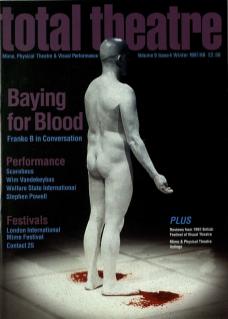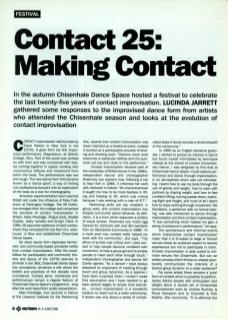Contact improvisation was founded by Steve Paxton in New York in the 1970s. It grew from his first improvised performance, Magnesium, at Oberlin College, Ohio. Part of the score was worked on with men and was concerned with bodies coming together in space; working with unconscious reflexes and movement from within the body. The performance was raw and rough. The new dance form first became known as a ‘dance sport'; a way of inviting non-professional dancers into an exploration of the body as a tool for choreography.
American experimentation soon reached British soil under the influence of Mary Fulkerson at Dartington College. The X6 Collective emerged from the college and comprised the pioneers of contact improvisation in Britain: Mary Prestidge, Fergus Early, Madée Duprès, Jacky Lansley and Emilyn Claid. In 1980, X6 assumed residence in East London, where they renovated the top floor of a warehouse in Bow and established Chisenhale Dance Space.
No other dance form espouses democ ratic and community-based principles better than contact improvisation. After the possibilities for participatory and community theatre and dance of the 1970s seemed to diminish in the '80s, Chisenhale Dance Space has consistently remained a site where the beliefs and practices of the decade were maintained. Contact jams, workshops and performances remain a regular feature of Chisenhale Dance Space's programme, long after the work faded from public presentation.
Mary Prestidge, now Lecturer in Dance at the Liverpool Institute for the Performing Arts, asserts that contact improvisation was never intended as a theatrical event, instead it evolved as a participatory process of sharing and showing work: ‘Dancers never wore costumes or particular clothes and the audience sat low and close to the performers.’
Contact improvisation became part of the vocabulary of British dance in the 1980s. Independent dancer and choreographer Rosemary Lee explains how, following a trip to New York in 1985, it informed her work with Jointwork in Oxford: ‘On a technical level it taught me how to be more fearless in lifting and helping to lift, which was critical because I was working with a man of 6'7".’
Partnering skills are key enablers in group work, and contact improvisation has shaped community dance because, by definition, it is a form which espouses a politics of equal access. Rosemary Lee made Egg Dances for Jointwork with over 80 members from an Oxfordshire Community in 1988. ‘In a more pure way, contact really helped my work with the community,’ she says. ‘The ethos of access was critical and I used contact to help people become confident with movement, to help a group gel and to enable people to meet each other through touch.’ Independent choreographer and dancer Gill Clarke agrees: ‘As a dancer I have always absorbed an enjoyment of meeting through touch and group dynamics. As a teacher I have been surprised when I couldn't make that assumption and I have needed to go back several stages to simple trust exercises... contact improvisation is a wonderful medium to reach out to a wider community. If dance was only about a series of complicated steps it would exclude a whole breadth of the community.’
In 1990 as an English Literature graduate, I wanted to pursue an interest in dance but found myself intimidated by technique classes at the school of London Contemporary Dance. I was delighted to find that at Chisenhale Dance Space I could explore performance and dance through improvisation, in an atmosphere which was not intimidating. I learnt how to use my body through the use of gravity and weight, how to work with partners by sharing weight, and how to feel confident lifting, turning upside down, exploring flight and height, and most of all I learnt how to enjoy working through movement. Nic Sandiland, a performer with no formal training, was also introduced to dance through improvisation and then contact improvisation. ‘It was something which helped me gain a sense of presence in performance,’ he says.
The spontaneous and informal events which characterise contact improvisation mean that it is ill-suited to large or formal venues where an audience expect to receive experiences but not to participate in them. Contact improvisation is best suited to intimate venues like Chisenhale. But can an artistic process which thrives on shared spontaneity communicate the intensity of a shared group dynamic to a wider audience?
For some artists there remains a 'pure’ form of contact which is possible to perform. Jackie Adkins speaks with enthusiasm and delight about a double bill of Chisenhale commissioned work by Andrea Buckley & Paula Hampson and Jo Chandler & Rick Nodine. She comments: ‘It reaffirmed the excitement and beauty and wonderfulness of contact improvisation. It was particularly exciting to see pieces which would otherwise not have existed and which enabled highly skilled artists to put their skills on the map.’ Rosemary Lee agrees: ‘As an audience member the most exciting work I have seen recently has been at Chisenhale, where performances have shown there is incredible talent and skill in this country that remains un-funded.’
The Contact 25 festival performances opened with an evening of improvisation. Only one of the three performances used contact improvisation. This was a duet performed by Rick Nodine and Karl Jay-Lewin. Whilst I appreciated the play with masculinity and the parallels found between combat and desire, I was not always able to engage directly with the piece. For Nic Sandiland, however, the duet was a clear example of when contact works well: ‘It was genuine, playful, untheatrical.’
But can a dance form which thrives on untheatrical values survive? That contact remains exploratory is, for many dancers, its main attraction. Jackie Adkins comments: ‘I became involved with contact improvisation because of the process. It's about asking questions, about being in a constant state of research, it’s always open-ended. Endings are dull.’
Mary Prestidge refers to contact as if it were a personality, a place and a journey to make and re-make: ‘It is a teacher, a tool, and a place to come back to, to find yourself in.’ Contact improvisation depends on what each performer brings to the performance. Relying on spontaneity and on the skill to respond to another's body, it is a profoundly honest dance form. In Mary's words: ‘You can't cheat or pretend because contact improvisation does not allow you to prepare; your preparedness is what you bring to a performance and where you arrive.’
Mary describes the international improvisation performed on Saturday 15 November by Benno Voorhan, Sue MacLennan, Lucia Walker, Yolande Snaith, Gaby Agis, Andrew Fifield and Stirling Stewart as a clear example of the way in which contact improvisation operates: ‘The performance was clearly structured. We designed the structure and then Sue devised the series of events. She wrote a dozen or so events down on paper, describing who was performing them... This enabled us to use a chance method of bringing a series of short events together. There were clear rules set. We decided who was present on the stage and who was lounging at the side. No performer was ever “off-stage”. A performer could be still or at the side of the performance space, but always part of the performance.’
Yolande Snaith comments that, through her return to contact improvisation, she realised what she's been missing: ‘This is a discipline. It provides you with the fitness, the strength, the imagination and the freedom.’ For Mary Prestidge, contact is a process towards choreography but it is not a theatrical event: ‘It teaches me clear skills, skills of how to look, perceive and listen. It teaches a state of mind and body which is alert. And it is a great way of warming up physically.’
At a conference on 23 November, a wide cross section of students, teachers and practitioners confirmed that contact improvisation is a widely used and ever evolving discipline. Increasingly students are asking to be taught the skill of contact as part of their dance training. Gill Clarke says: ‘If I had another life, I would love to explore contact more. It is all about play. I enjoy the surprise of playfulness. What's wonderful is a partnering not only of weight but of energy and a sharing of the pathways of energy. A partner can always surprise you by taking you somewhere new and unexpected.’
Sadly Chisenhale Dance Space is currently threatened with closure. Its demise would be a sad loss to the dance world because of its commitment to experiment and participation. Contact improvisation has been a valid part of this process; the excitement of sharing unexpected movement and spontaneous journeys with partners makes the discipline so rewarding. It is a profoundly democratic art form which is uniquely positioned to welcome a larger audience and practising community.

